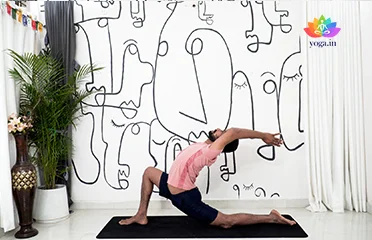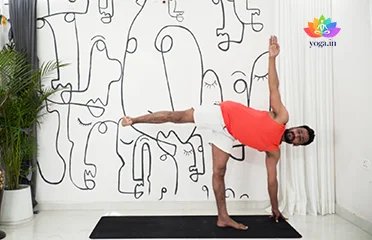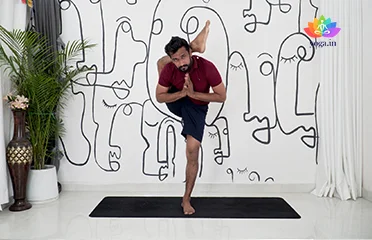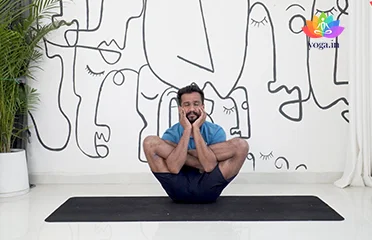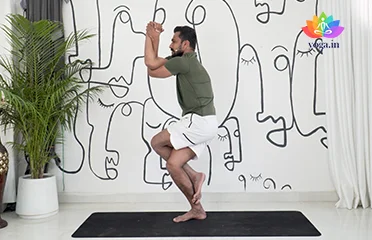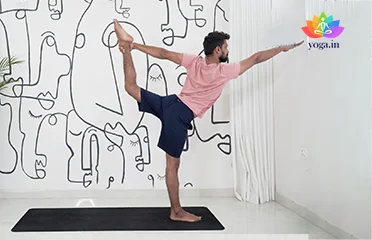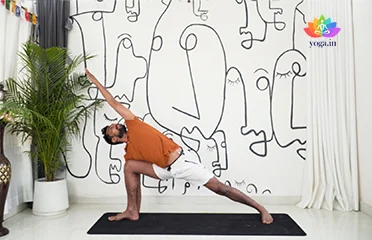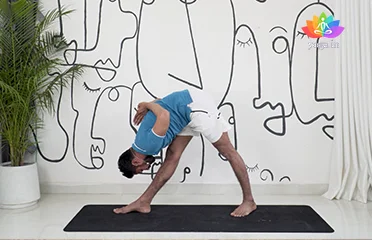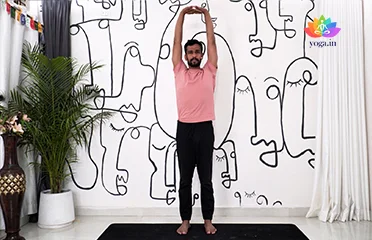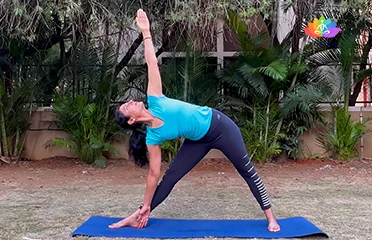Anjaneyasana (Crescent Moon Pose)
आंजनेयासन / Crescent Moon Pose
The Sanskrit name is derived from Anjane (आंजने) meaning Hanuman, [�K]
Ardha Chandrasana (Half Moon Pose)
अर्धचन्द्रासना / Half Moon Pose
The Sanskrit name is derived from Ardha (अर्ध) meaning half, Chandra [�K]
Durvasasana (Sage Durvasa’s Pose)
दुर्वासासना / Sage Durvasa's Pose
The Sanskrit name is derived from the word Durva (दुर्वा) which [�K]
Garbha Pindasana (Womb Pose)
गर्भ पिण्डासना / Womb Pose
The Sanskrit name is derived from the word Garbha (गर्भ) meaning an [�K]
Garudasana (Eagle Pose)
गरुडासन / Eagle Pose
The Sanskrit name is derived from Garuda (गरुडा) meaning eagle and [�K]
Natarajasana (Lord of the Dance Pose)
नटराजासन / Lord of the Dance Pose
The Sanskrit name is derived from Nata (नट) meaning dance, Raja (राजा)) [�K]
Parsvakonasana (Extended Lateral Angle P
पार्श्वकोनासन / Extended Lateral Angle Pose
The Sanskrit name is derived from Parsva (पार्श्व) meaning side, [�K]
Parsvottanasana (Intense Side Stretch Po
पार्श्वोत्तनासनम् / Intense Side Stretch Pose
The Sanskrit name is derived from parsva (पार्श्वो) meaning [�K]
Tadasana (Mountain Pose)
ताड़ासन / Mountain Pose
The sanskrit name is derived from tada (ताड़ा) meaning mountain and [�K]
Trikonasana (Triangle Pose)
त्रिकोणासन / Triangle Pose
The sanskrit name is derived from three Sanskrit Words: Tri (त्रि) meaning [�K]
- 1
- 2
Standing Yoga Poses: Building Strength and Balance
Standing yoga poses, or standing asanas, are fundamental to a well-rounded yoga practice. These postures challenge balance, strength, and flexibility while also improving focus and body awareness. By incorporating standing poses into your routine, you can enhance overall physical and mental well-being.
Benefits of Standing Yoga Poses
- Improved balance and stability: Regular practice of standing poses helps strengthen the core muscles and ankles, enhancing balance and stability.
- Increased strength: Standing poses engage various muscle groups, leading to increased strength and tone.
- Enhanced flexibility: Many standing poses stretch the legs, hips, and spine, improving flexibility.
- Improved focus and concentration: Maintaining balance in standing poses requires mental focus and concentration.
- Boosted energy levels: Standing poses stimulate circulation and can increase energy levels.
List of Standing Yoga Poses
- Tadasana (Mountain Pose): This foundational pose establishes proper alignment and balance. Engage your core, legs, and arms while standing tall with your feet hip-width apart.
- Virabhadrasana I (Warrior I Pose): This pose strengthens the legs, arms, and core while improving balance and flexibility. Step one leg back into a lunge, with your front knee bent and your arms extended overhead.
- Virabhadrasana II (Warrior II Pose): Similar to Warrior I, but with feet wider apart and arms extended parallel to the floor. This pose enhances hip opening and stability.
- Trikonasana (Triangle Pose): This pose stretches the spine, legs, and torso while improving balance and flexibility. Extend your arms to the sides, reaching one hand to your ankle and the other towards the ceiling.
- Utthita Parsvakonasana (Extended Side Angle Pose): This pose deepens the hip opening and strengthens the legs, core, and arms. Stack your feet and reach towards your front ankle, with your top hand extended towards the ceiling.
- Utthita Hasta Padangusthasana (Extended Hand-to-Big-Toe Pose): This pose challenges balance and improves flexibility in the hamstrings and hips. Hold your big toe with your hand and lift the other leg towards the ceiling.
- Vrksasana (Tree Pose): This pose cultivates balance and focus. Stand on one leg and place the sole of your foot on the inner thigh of the standing leg.
Tips for Practicing Standing Yoga Poses
- Engage your core: A strong core is essential for balance and stability in standing poses.
- Maintain proper alignment: Focus on aligning your spine, hips, and shoulders to prevent injuries.
- Use props: If needed, use props like blocks or a chair for support as you build strength and flexibility.
- Practice regularly: Consistent practice will improve your balance, strength, and overall performance.
- Start slowly: Begin with basic poses and gradually progress to more challenging ones.
Common Challenges and How to Overcome Them
- Lack of balance: Start with easier poses and gradually increase difficulty. Use yoga props for support as needed.
- Tightness in the legs: Incorporate hamstring stretches and hip openers into your practice.
- Difficulty focusing: Practice mindfulness and meditation to improve concentration.


